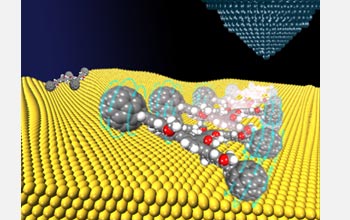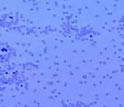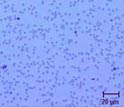News Release 09-080
"Fantastic Voyage" Not So Far-fetched
Studies yield clues to powering nano-sized machines

Powering machines 5,000 times smaller than a human cell moves closer to reality.
April 23, 2009
View a video of real-time "predator-prey" behavior of silica spheres towards UV-illuminated silver chloride.
This material is available primarily for archival purposes. Telephone numbers or other contact information may be out of date; please see current contact information at media contacts.
A new paper published in the May 2009 issue of the oldest continuously published magazine in the United States, Scientific American, asks readers to imagine producing vehicles so small they would be about the size of a molecule and powered by engines that run on sugar. To top it off, a penny would buy a million of them.
The concept is nearly unthinkable, but it's exactly the kind of thing occupying National Science Foundation supported researchers at Penn State and Rice universities.
For several years, Ayusman Sen, who heads Penn State's department of chemistry, and his colleague Thomas E. Mallouk, director of the Center for Nanoscale Science at Penn State, have investigated technologies that could realize these remarkable machines whose uses might include delivering medicine to specific tissue, accomplishing surgeries or communicating with the outside world from inside the human body.
Though researchers consistently have improved ways to build nano-machines, the stumbling block has been finding a way to power them. Shrinking energy producers--internal combustion engines, electric motors or jet engines--below millimeter dimensions is not an easy task, but researchers may be closer to a fantastic solution.
In the 1966 movie Fantastic Voyage, scientists shrink a submarine to microscopic size and inject it into the blood stream of a brilliant scientist, who has a blood clot forming in his brain. The nano-sized surgeons then set out to remove the blood clot.
Today, researchers can steer nano-machines, use them to convey cargo, and guide them using electromagnetic forces or chemical interactions. All of this, they say, makes the world seen in Fantastic Voyage not so far-fetched.
-NSF-
-
View Video
Real-time predator-prey behavior of silica spheres towards UV-illuminated silver chloride.
Credit and Larger Version -
Nano-car has no engine under the hood, but rolls on wheels 5,000 times smaller than a human cell.
Credit and Larger Version -
Salmonella bacterium provides an example of how nano-machines could be powered.
Credit and Larger Version -
Particle motion driven by light provides a theory for independent movement of nano-machines.
Credit and Larger Version
Media Contacts
Bobbie Mixon, NSF, (703) 292-8070, email: bmixon@nsf.gov
Program Contacts
Thomas P. Rieker, NSF, (703) 292-4914, email: trieker@nsf.gov
Principal Investigators
Ayusman Sen, Penn State University, (814) 863-2460, email: asen@psu.edu
Thomas E. Mallouk, Penn State University, (814) 863-9637, email: tom@chem.psu.edu
Related Websites
How to Build Nanotech Motors - Scientific American: http://www.sciam.com/article.cfm?id=how-to-build-nanotech-motors
The Sen Group - Supporting Information: http://bit.ly/1Vmb8Gb
The U.S. National Science Foundation propels the nation forward by advancing fundamental research in all fields of science and engineering. NSF supports research and people by providing facilities, instruments and funding to support their ingenuity and sustain the U.S. as a global leader in research and innovation. With a fiscal year 2023 budget of $9.5 billion, NSF funds reach all 50 states through grants to nearly 2,000 colleges, universities and institutions. Each year, NSF receives more than 40,000 competitive proposals and makes about 11,000 new awards. Those awards include support for cooperative research with industry, Arctic and Antarctic research and operations, and U.S. participation in international scientific efforts.
Connect with us online
NSF website: nsf.gov
NSF News: nsf.gov/news
For News Media: nsf.gov/news/newsroom
Statistics: nsf.gov/statistics/
Awards database: nsf.gov/awardsearch/
Follow us on social
Twitter: twitter.com/NSF
Facebook: facebook.com/US.NSF
Instagram: instagram.com/nsfgov




